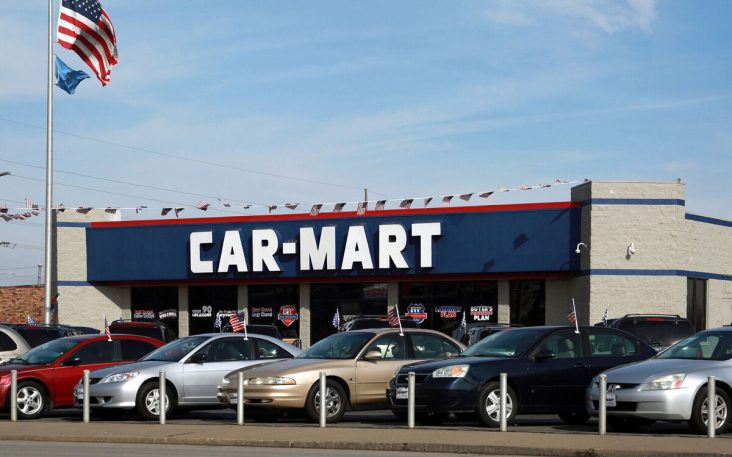Analysts: Car-Mart earnings to be flat in third quarter, revenue to rise
by February 10, 2022 3:16 pm 772 views

Rogers-based America’s Car-Mart Inc. is expected to post an earnings decrease and a revenue increase for the third quarter of fiscal 2022 amid tightening margins and high vehicle prices, according to analysts.
After the markets close Wednesday (Feb. 16), Car-Mart is expected to report earnings fell to $2.82 per share in the quarter ending Jan. 31, from $2.85 per share in the same period last year, based on a consensus of four analysts. Revenue is projected to rise by 6.2% to $242.41 million, from $228.26 million.
In an earnings preview, equity analysts John Hecht and Kyle Joseph and equity associates Matthew Hurwit and Hogan Yang, all of Jefferies, noted the earnings estimate for the buy here, pay here used car dealer is similar to the same period last year. The analysts expect higher sales volumes and interest income to be offset by the increased cost of sales, general and administrative expenses, and higher provision. Cost of sales is projected to be $150 million, with selling, administrative and general expenses at $40 million.
They expect loss rates to rise, contributing to a provision expense of $64 million. Combined, expenses are expected to rise by 27% to $257.3 million, from the same period last year. Gross adjusted margin on auto sales is expected to be 38.6%, down from 40.6%. Vehicle sales are expected to rise by 5% to about 15,000, and retail sale price is expected to be up 15% to about $15,700. The analysts said car sales continue to be impacted by low supply and ongoing supply chain disruptions.
“(Car-Mart) has effectively navigated an evolving used car market and remains well-positioned competitively vs. indirect lenders and other (buy here, pay here) operators,” the analysts said. “Like others in the space, (Car-Mart) has shown signs of initial credit normalization and has effectively controlled costs.”
Car-Mart has been working to move from a collections company to a sales company that can collect while increasing customer numbers per dealership. The analysts expect this will lead to increased investments in procurement and sales and marketing and more customers.
Some offsetting factors for Car-Mart include higher used car prices and tighter credit, which should benefit sales, according to the analysts. They lowered Car-Mart’s 12-month target price by $15 to $115 and maintained a hold rating for the stock.
Shares of Car-Mart (NASDAQ: CRMT) closed Thursday (Feb. 10) at $95.40, down $3.14 or 3.19%. In the past 52 weeks, the stock has ranged between $88.70 and $177.45.
BROADER TRENDS
In January, the Manheim Used Vehicle Value Index rose by 45% to 236.3, from the same month in 2021. Wholesale used vehicle prices were flat in January, from December.
According to Cox Automotive, used vehicle sales declined by 0.8% in January, from the same month in 2021. The supply of used retail vehicles was 51 days at the end of December, down from 54 days at the same time in 2020, according to vAuto data. Over the same period, wholesale supply declined to 26 days, from 32 days.
In a report on the broader auto finance market, Hecht, Joseph, Hurwit and Yang expect auto lenders’ earnings to reflect seasonal factors, including lower volumes and higher delinquencies. However, “we don’t anticipate any curveballs on the reports. More important, we think the focus will be on transitioning trends into ’22, including tightened volume capacity given (manufacturing) and inventory constraints, normalizing credit and (net interest margin) within a rising rate environment.”
The analysts expect 2022 volumes to moderate amid affordability and supply issues. Over the past year, the amount financed for a used vehicle has risen by 20% to $25,909. Meanwhile, the average monthly payment for new vehicles increased by 8% to $609. The analysts noted two factors to watch: the impact on credit risk from higher monthly debt servicing and lower unit volumes tied to unaffordability.
The analysts also expect credit to slowly become more normal “from historically benign levels. Questions of concern now include ‘how should I perceive credit normalization, how long will high residual values support credit,’ and ‘will volumes be sufficient to support portfolio growth.’”
This year is not expected to be as strong as 2021, but equity values and stock performance “may hold up given comparative value to the overall market,” the analysts said. Used volumes might soften this year amid flat residual values and rising net charge-offs. Still, they believe 2022 could be another positive year for equity values.
Residual values are expected to remain high “for a good portion of ’22,” according to the analysts. “Unit level demand has moderated slightly for used cars, but prices remain near all-time highs. Given ongoing supply constraints tied to low off-lease in-flows and chip shortages which continue to affect new car production, we expect elevated price levels may persist… While this will support credit on high recovery rates, we believe this will also negatively impact volumes as affordability issues constrain demand.”
According to the analysts, losses look “to be developing at a slower pace than (the) market expects, and we note reserve levels remain adequate in a historical context. Current normalization trends suggest (delinquencies) reaching cycle average levels in mid-2023, which leaves room for upside to our estimates.”
